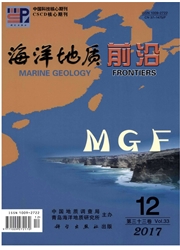

 中文摘要:
中文摘要:
以沉积学基本原理为指导,借助三维地震资料,综合相干技术和属性提取技术对北黄海盆地东部坳陷西北区的沉积体进行了识别。精细刻画了新近系底部砾岩之上河道—扇体沉积体系的平面及剖面特征,从而建立了河道—扇体沉积古环境展布图。研究表明:河道—扇体沉积期,来自西北部的物源在研究区的平缓地势下持续演化形成了稳定曲流河。河道上游下切深度大、侧向迁移不明显;中游下切深度小、侧向迁移距离大,点坝及废弃河道等发育;下游段单河道变为两个或多个并置,主河道数增加。河流的末端逐渐向片流转化从而堆积形成了类似末端扇的沉积。该河流—扇体沉积体系的发现,证明研究区存在持续一定时间的暴露性沉积间断,沉积古环境由原地或近原地堆积的近源冲积沉积转变为典型的远源曲流河道—扇体沉积,为今后环境地质研究提供佐证。
 英文摘要:
英文摘要:
The Neogene sequence in the northwest block of the Eastern Depression of the North Yellow Sea Basin are studied based on high-resolution 3Dseismic data,using the coherence and attribution extracting approach.A channel-fan system above the Neogene basal conglomerate is recognized.It was a meandering river system carrying detrital sediments from northwest upon a relatively gentle geomorphology.In the upper reach of the river,the river channel was deeply incised with little lateral migration.In the middle reach of the river,however,the incision was gentle and there was distinctive lateral migration.Point-bars and abandoned channels were well developed.In the lower reach,single channel turned into juxtaposed dual or multiple channels.At the end of the river,it became a kind of sheet flow and formed the deposits similar to a terminal fan.It suggests that the area was exposed to air for a substantial span of time,and changed from proximal alluvial deposits to a distal typical meandering river-fan deposits.
 同期刊论文项目
同期刊论文项目
 同项目期刊论文
同项目期刊论文
 期刊信息
期刊信息
